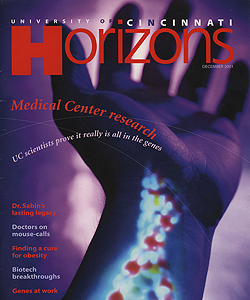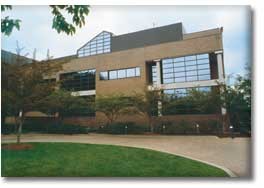by Mary Niehaus
Mystery. Beauty. Power. The tiny cells that make up the human body boast all three, though few of us give them a second thought.
Internationally distinguished biomedical researcher David Millhorn of UC's College of Medicine has a special appreciation for human cells. Not only for the work they perform, but for the secrets they may reveal about human health.
"Cells are always changing," the researcher points out. "They change during development. They change in women, based on their hormonal cycle. Cells are always varying in their function to allow us to survive. If you were to go to very high altitudes, for example, your cells would respond to the low oxygen environment.
"That's normal. That's the beauty of the way cells work.
"Of course, we'd like to know how cells do that," Millhorn smiles.
What about cancer, when cells go out of control, dividing and invading other tissues and preventing them from working properly? "What we'd like to know about that, from a genetic standpoint, is why those cells start the process of dividing again," he replies.
"But the mystery of science and health is not just in disease. Normal function holds many of the keys to understanding diseases."
That is why researchers will investigate both aspects of cell activity at the University of Cincinnati's new Genome Research Institute, a state-of-the-art operation with Millhorn as director. Sophisticated bioinformatics (computerized analysis of biological data) are ready to support his scientific team's study of information from newly sequenced genome projects, both human and simpler creatures.
"Technology such as genomics (study of genes) and proteomics (study of proteins) will be used hand in hand, to help us understand various complex functions such as how cancer cells become cancer cells," the director explains. "How the hormones work. How the neurons function. What the basis is of neurodegenerative diseases. Those are the types of problems that we want to address."
Millhorn is aware of how fortunate the university is to be able to bring such a research institute to life. The project came together with an amazing synergy: A gift of modern laboratory buildings on a 23-acre site. Excellent scientific staff to get the venture started. Approval to recruit more high-level talent. Enthusiasm from top administrators who see it as a unique opportunity for UC to take national leadership in genomic research.
"This is an opportunity that comes very, very infrequently," says Millhorn, who is also continuing as chairman of molecular and cellular physiology at the College of Medicine. "To have this much laboratory space to create a new research institute is something that very few universities have a chance to enjoy. So it is imperative that we make the best of this."
The University of Cincinnati's new institute for genome research is located in 360,000 square feet of lab and office space formerly occupied by Aventis Pharmaceuticals in nearby Reading, Ohio. The gift, estimated at $100 million to replace, is the largest single donation ever received by UC. Renovations are now under way to adapt laboratories for academic research and to update information technology and environmental systems to university levels.

 Past Issues
Past Issues
